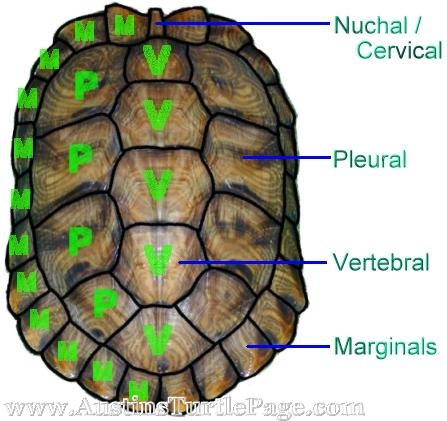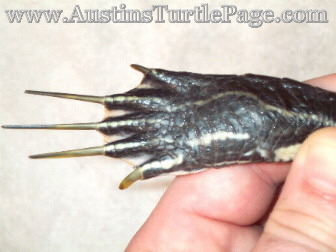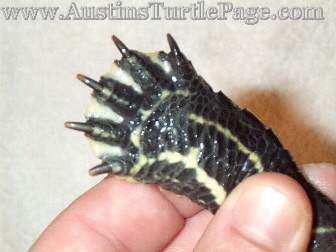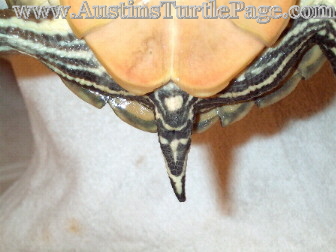|
|
|
|
|
This page's main objective is
to educate you on some of the little things about turtles that
some may or may not already know. I've learned a lot in
the time I've been dealing with them. Most of the information on ATP comes from
my personal experience with some additional information has been
added in from other experienced keepers. If you share a different
view point on anything said on this or any of the other pages or have some
information that you feel should be included,
feel free to E-Mail me with your comments. The advice offered here is not the
end-all, be-all of turtle care. I am simply providing information
that I have learned over the years through education, experience and
dealing with other long-term and dedicated keepers and breeders.
A little further down, I will dispel some of the commonly accepted rumors and will hopefully give you a better insight into keeping turtles. If you have heard any common misconceptions that aren't listed here, please email me so that I can get those added in. Please, read on, learn what you can and have fun being around turtles! |
||
|
|
|
|
|
|
|
|
A turtle is any reptile that lives in a shell. A tortoise is a turtle that lives on the land but can enter the water for a drink, to cool off or to escape and evade predators. A terrapin is a turtle that lives primarily in water, generally leaving only to lay eggs or to bask in the sun. |
|||
|
|
|
|
|
|
|
|
Yes. One key thing to keep in mind: If it has a mouth, it can bite! If you would like to feed your by hand, I would recommend doing so with tongs, as some turtles may not have as good of aim as you hope they do. |
|||
|
|
|
|
|
|
|
|
Turtles, for the most part, are not aggressive to people. Most turtles are like people or any other pet you have. They have their own personalities and temperaments. Some of ours are aggressive if you pull them out of the water, yet docile in the water and do not attempt to bite. Some of the others are quite different. They will try to run if you remove them from the tank, yet if you place your hand inside the water...well, look out. They think your fingers are chicken tenders! Turtles have a tendency to bite each other accidentally, especially when trying to grab a hold of the same piece of food. Even the supposedly "ferocious" Alligator Snapping Turtle. The Alligator in the name came from its appearance, not its temperament. |
|||
|
|
|
|
|
|
|
|
Myths surround almost everything in the world today and turtles are no different. From the old wives tales and legends to modern day misconceptions on care and turtles themselves. Hopefully the following list which will continually grow over time will be of some assistance to you. "When a turtle bites you, it won't let go until it hears thunder." As entertaining as this legend is, it is most definitely false. If there was any semblance of truth to this myth, well, I'd have several issues. "Turtles will give you Salmonella." Yes and no. Owner or handling a turtle will not automatically cause you to get sick with salmonella or anything else, just as eating chicken, eggs or pork is a risk for salmonella poisoning every time. People are generally suffer from turtle-contracted salmonella are people who don't provide proper care for their turtles and also have poor personal hygiene practices. After handling turtles or cleaning their habitats, it is always a good idea to wash your hands. You aren't going to use your hands to clean out your cat's litter box without washing your hands afterwards, so why would you clean out the turtle's home (where they eat and use the bathroom) without washing your hands? Additionally, since turtles swim where they eat, drink and use the bathroom, it stands to reason that you should wash your hands afterwards. Additionally, simply because of immune systems, it is recommend that turtles and their housing not be handled by young kiddos, the elderly or those with compromised immune systems. Keepers all over the world have successfully kept and bred turtles over decades and have never gotten ill. "It is illegal to own a turtle under 4 inches." There are some states where buying a turtle is illegal and others where it is illegal to buy a turtle that is under a shell length of 4 inches, but this involves the buying and selling, not the owning of a turtle. The only time it is illegal to own a turtle or own more than a certain number of a certain species is when it involves a protected species. It is not illegal to own or to buy a turtle under a shell length of 4 inches, again, unless it is a protected species. "Turtle urine causes brain damage in humans when it comes in contact with your skin." While this is medically incorrect, it would make sense in my case and explain an awful lot. "A turtle will only grow to the size of its enclosure." As you will learn further on as you explore ATP, you'll learn why this is false. Turtles will continue to grow, regardless, provided that proper husbandry (feeding, temperatures, habitat and health) are maintained. "Turtles can leave their shell." The only time a turtle will depart from its shell is when it's dead. Remember, a turtle's shell is nothing more than an outwardly visible (and often very attractive), over-sized rib cage. "Turtles can eat pizza, chocolate and hot dogs." Turtles can eat pizza, chocolate and hot dogs. But just because they can, doesn't mean they should. I could sit here at my desk, typing this, and eat the computer graphics card that's sitting on my desk but it wouldn't do me any good and could potentially have severe consequences to my health. When people and animals eat things that they shouldn't, bad things can happen. "Baby turtles need shallow water because they can't swim well." Another common misbelief. Baby turtles have the same ability to swim and survive in deeper water (species dependant [ie; even an adult mud turtle can't survive in deep water - consult the care sheets for each species]). consider this...in the wild, if baby turtles were not able to survive in deep water, they would be discovered and eaten by many predators. They, like adults, use deep water for safety. Provided it is a species that accepts deep water, there is no problem with keeping a hatchling adult of those species in a 55 or 75 gallon aquarium, filled to the top. Just ensure they can't escape. "Turtles that have been kept in shallow water don't know how to swim and will drown if put in deep water." Turtles are exceptional swimmers by nature, provided it is a species that is indeed aquatic and requires deep water (see Care Sheets if in doubt). They don't undergo swimming lessons and they don't forget how to swim. It may take a turtle that has been poorly kept in shallow water for 10 years a few hours to get use to the depth, but by no means should a healthy turtle drown or have any problems adjusting. |
||
|
|
|
|
|
|
|
|||||||
Ok. The top of the shell is called the carapace whereas the bottom portion is called the plastron. The part of the shell that connects these two is called the bridge. Pretty simple, eh? Ok. Now, the carapace does not have scales as we know scales to be. They have large sections that are called scutes. Scutes are made of kertain, much like our fingernails. The cloaca is an opening in the body located under the tail. Through this opening, the turtle performs fecal, urinary and reproductive functions. Turtles CAN feel things that come in contact with their shells because they have nerve endings there, but they can not feel pain as they do not have those types of nerve endings. Why is this? I haven't the slightest of clues but have seen it in most research material so I'm guessing it's true. Kinda hard to ask the turtle if something hurts.
Continuing on with the anatomy portion of this little block of info, we go to the lungs. If you have ever heard a turtle hiss and wonder if it means that they are mad...rest assured, they aren't mad. They are frightened. When we breathe, our chest expands and then contracts, pulling in air and then releasing it. Well, a turtle's chest can't do this because of the hard plastron. Instead, their lungs inflate and take up room inside their shell. So when they are frightened, and they need to pull their head and legs into their shell, they won't quite fit in because of full inflated lungs. What they do is expel the air within their lungs out as fast as they can so that they will have room for their appendages to fit into the security of their hard shells. With this rush of air leaving their bodies, it makes a hissing noise and leads one to believe the turtle is ticked off and warning them to stay away. And, just a note for the record, no turtle (land or otherwise) can leave their shell and still be alive. If you see a turtle shell and there is no turtle to be found, the poor creature is dead. They are attached to their shell as it is actually a part of their rib cage. The shell grows at the same rate the rest of the turtle, so there is hardly a need of concern of the turtle getting too fat for its shell. When the shell begins to look as if it is coming apart, it is merely growing; discarding portions of the old with incoming segments of new. If the scutes come off in large layers or there are red and / or raw areas in shed areas, then there is a problem. Go see a vet. As the turtle grows, you will see a separation of the scutes and a lighter colored area between them on the plastron. Again, this is normal. This area will also be softer than the surrounding scutes. |
|||||||||
|
|
|
|
|
|
|
||||||||||
This is difficult to tell is most turtles, until they are older. The males of all turtles will have a longer, thicker tail, with the cloaca located closer to the tip of the tail, whereas females with have a smaller, thinner tail with the vent closer to the main part of the body. In some of the more commonly kept turtles (Sliders, some Maps, Painteds, Cooters), males will also have exceptionally long foreclaws; the females having smaller ones. Males in some species will also display a concave or dented-in plastron. This is to allow the male to better mount the female when mating. Adult females which have laid a clutch of eggs will have a semi-pliable anal section of the plastron.
The females, however, in most species of turtles, will be larger...sometimes 4 x larger...than the males. And just be on the look-out - if you have a male, he might just prove it to you one day. This is called Fanning. This is completely normal, however, sometimes this fanning can lead to health issues - especially if tankmates believe it to be something edible and bite it. |
||||||||||||
|
|
|
|
|
|
|
|||
The measurement of a turtle is done as a straight line from the front of the carapace to the back. This is called Straight Carapace Length (SCL). This is accomplished by using an imaginary line that goes through or above the turtle. You do not want to go along the ridge of the carapace, because in some species this is highly domed and wil give you an inaccurate measurement. Picture it as though you were placing bookends and the front and back of the turtle, and then measuring the distance between bookends.
|
|||||
|
|
|
|
|
|
|
|
Could be. But before you go off the deep end and think your turtle is going to kill you or infect you with this bacteria, let's look at a few things. ALL animals can carry salmonella. Yes. ALL of them. This includes dogs, cats, people, lizards and snakes. Even your cute little puppy Rover might have it. It's not going to jump out of the turtle and get you. The reason why turtles have received a bad reputation in reference to salmonella poisoning, is because of ignorance combined with a lack of personal hygiene. Keepers back in the 60's and 70's (when this was a problem thus creating the 4-inch law), were not keeping their turtles in very sanitary conditions and they were not keeping themselves safe by washing their hands. Turtles were commonly kept in Turtle Bowls which have come to be dubbed "Death Bowls" by hobbyists. The water was not filtered and was usually changed once a week or when the keeper got tired of smelling the foul water. The turtles were left to live in, swim in and eat in the same water that they used the bathroom in. Then people would go about their day and not wash their hands - no wonder people were getting sick. That's the equivalent to having a dog and keeping it in a single room inside your house all the time and making it eat off the floor where it uses the bathroom...and then you clean it once a week. That's just begging for all kinds of health issues. The turtle's water is no different. Even with the water being filtrated and caring for your turtles properly, it is always a good idea to wash your hands after interacting with them or their habitat. You wash your hands after brushing your dog or horse, so why not wash them after testing your turtle's water or after putting your hands in the aquarium to adjust something? I would also encourage washing your hands with a strong, anti-bacterial soap before touching them as well. You don't want them to give you anything that they might have and you don't want to give them anything you might have. Play it safe and play it smart. Children should not be allowed to touch the turtles and if they are permitted, please only do so under strict adult supervision and wash the child's hands IMMEDIATELY after touching them. Kids are quick to put hands in their mouths and that is an excellent way for the transfer of bacteria to happen. Their immune systems are still relatively weak and they can pick up germs easily - not just salmonella. Elderly people and those with compromised immune systems (such as AIDS and other afflictions of the immune system) are also encouraged not to interact with reptiles. |
|||
|
|
|
|
|
|
|
|
There are a few reasons for the law stating that the turtle needs to be 4 inches or larger for sale as a pet. Some of the reasons are far-fetched, but they were believed at te time. All of which were based on salmonella poisoning. Children of those days were allowed to play with the little hatchling turtles. Kids are kids and they do what kids do - they put whatever they are playing with in their mouths. Not the best idea, but again, kids are kids. So these little turtles fit nicely in the mouths of young kids and thus assisted in the spreading of germs and bacteria. It seems the parents would rather blame the turtle for their child being sick, when in fact, they should have been paying closer attention to their kids and their turtles. Another reason is that before we understood that salmonella was an important part of their gut bacteria, it was believed that if turtles lived to be 4 inches, then they had survived salmonella and were thus salmonella-free. We now know this to be false. It is not illegal to OWN a turtle under 4" in length; it is illegal to SELL a turtle less than 4" as a PET. Key word..."pet". This is why it is legal to purchase them from breeders and dealers on the internet who support the "hobby" as opposed to pet stores which sell the turtles as "pets". There is a great debate in the courts and hobby of turtle keeping, and one that will probably continue for years down the road. You can read about this law here. |
|||
|
|
|






